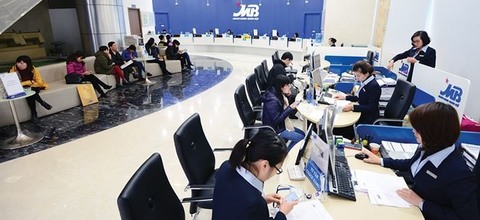
Fitch Ratings upgraded the long-term issuer default rating (IDR) of Military Bank to ‘B+’ from ‘B’. — Photo Military Bank
Fitch Ratings on Tuesday upgraded the long-term issuer default rating (IDR) of Military Commercial Joint Stock Bank (Military Bank) to ‘B+’ from ‘B’ with a stable outlook. Fitch also upgraded the bank’s viability rating to ‘b+’ from ‘b’.
In a report released on Tuesday, the agency also upgraded the viability rating of Joint Stock Commercial Bank for Foreign Trade of Vietnam (Vietcombank) and Vietnam Joint Stock Commercial Bank for Industry and Trade (Vietinbank) to ‘b’ from ‘b-’.
The long-term IDRs of Vietnam Bank for Agriculture and Rural Development (Agribank), Vietinbank and Vietcombank have been affirmed at ‘B+’ with a positive outlook. The IDR of Asia Commercial Joint Stock Bank (ACB) has been affirmed at ‘B’ with a stable outlook.
“The positive rating action takes into account the Vietnamese banking system’s enhanced operating environment, with improved economic policymaking from authorities promoting macroeconomic stability and predictability,” Fitch noted, adding this has enabled banks to significantly reduce their exposure to legacy problem loans that have long weighed on their balance sheets and offsets, in part, the banking system’s long-standing structural weaknesses, such as thin capital buffers and weak profitability, which is expected to be more adequately addressed in the long run.
According to Fitch, the upgrade of Military Bank’s viability rating and long-term IDR takes into account its higher capital levels compared to peers and continued asset quality improvement, as reflected in its more diversified loan composition and declining problem-loan ratio (2.9 per cent at end-2017 and 6.8 per cent at end-2015). The bank’s Fitch core capital ratio of 11.4 per cent at the end of June 2017 was the highest among that of Fitch-rated Vietnamese banks.
Fitch expects Military Bank to continue generating higher profitability than peers, supported by a wider net-interest margin and leaner cost structure, which has aided its internal capital generation. The bank’s operating profit/risk-weighted assets ratio of 2.3 per cent is likely to stay above that of the majority of local peers. The bank’s loan/deposit ratio increased to 88 per cent at the end of June 2017 due to rapid loan growth.
The long-term IDRs of Military Bank and ACB are driven by their viability ratings and reflect their smaller franchises but better loan quality compared to State-owned banks. Fitch believes the capital encumbrance of ACB and Military Bank from under-reporting of non-performing loans is lower compared to State-owned banks.
ACB’s ratings also reflect its improving asset quality and profitability profile. Its loan quality is likely to be better than most of its peers given its much lower loan concentration risk, with a small one per cent exposure to State-owned enterprises at the end of June 2017. The bank’s problem loan ratio improved significantly after writing off its entire bad debt and being sold to Vietnam Asset Management Company (VAMC) in 2017, Fitch said.
“We expect ACB’s improving profitability to continue in the near term, as legacy problem exposures are mostly provisioned for and the full resolution of bad debts sold to VAMC should alleviate its credit cost burden. The bank’s operating profit/risk-weighted assets ratio improved to 1.9 per cent in 2017 from its four-year average of 1.2 per centuntil the end of 2016,” Fitch said in the report.
The stable outlook on Military Bank and ACB reflect Fitch’s expectation that their asset quality and profitability profiles will be maintained over the near- to medium-term amidst macroeconomic stability in Viet Nam.
The upgrade of Vietcombank and Vietinbank’s Viability Ratings reflects the banks’ improvement in asset quality, with problem loan ratios---comprising reported non-performing loans, bad debt sold to VAMC and special mention loans---improving to 2.4 per cent and 2.8 per cent at the end of June 2017, from 5.1 per cent and 3.4 per cent, respectively, at the end of 2015. This was supported by the benign operating environment and strong retail loan growth. Vietcombank’s full resolution of bad debts sold to VAMC in 2016 will lower its credit cost burden.
“Our assessment also incorporates the banks’ strong domestic franchises but limited balance sheet strength relative to problem assets and growth aspirations. Fitch core capital ratios of 8.8 per cent for Vietcombank and 6.9 per cent for Vietinbank are low and require capital raising in the run-up to the implementation of Basel II by January 1, 2020. Internal capital generation remains weak, as evidenced by low operating profit/risk-weighted asset ratios of 1.8 per cent for Vietcombank and 1.4 per cent for Vietinbank from 2013-2017,” Fitch noted. — VNS